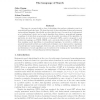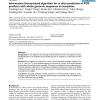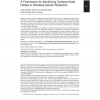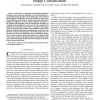BMCBI
2005
14 years 5 months ago
2005
Background: The most common method of identifying groups of functionally related genes in microarray data is to apply a clustering algorithm. However, it is impossible to determin...
BMCBI
2005
14 years 5 months ago
2005
Background: Clustering is a key step in the analysis of gene expression data, and in fact, many classical clustering algorithms are used, or more innovative ones have been designe...
JAIR
2007
14 years 5 months ago
2007
This paper is concerned with a class of algorithms that perform exhaustive search on propositional knowledge bases. We show that each of these algorithms defines and generates a ...
BMCBI
2005
14 years 5 months ago
2005
Background: A new algorithm for assessing similarity between primer and template has been developed based on the hypothesis that annealing of primer to template is an information ...
TISSEC
2008
14 years 5 months ago
2008
compromised sensor nodes. The framework provides an appropriate abstraction of applicationspecific detection mechanisms and models the unique properties of sensor networks. Based o...
TIP
2008
14 years 5 months ago
2008
In this work, we investigate how illuminant estimation techniques can be improved, taking into account automatically extracted information about the content of the images. We consi...
TIP
2008
14 years 5 months ago
2008
An overview of the classification-based least squares trained filters on picture quality improvement algorithms is presented. For each algorithm, the training process is unique and...
TEC
2008
14 years 5 months ago
2008
When hypervolume is used as part of the selection or archiving process in a multiobjective evolutionary algorithm, it is necessary to determine which solutions contribute the least...
TEC
2008
14 years 5 months ago
2008
We propose the use of a new algorithm to solve multiobjective optimization problems. Our proposal adapts the well-known scatter search template for single objective optimization to...
TEC
2008
14 years 5 months ago
2008
Evolutionary Algorithms (EAs) are well-known optimization approaches to cope with non-linear, complex problems. These population-based algorithms, however, suffer from a general we...




